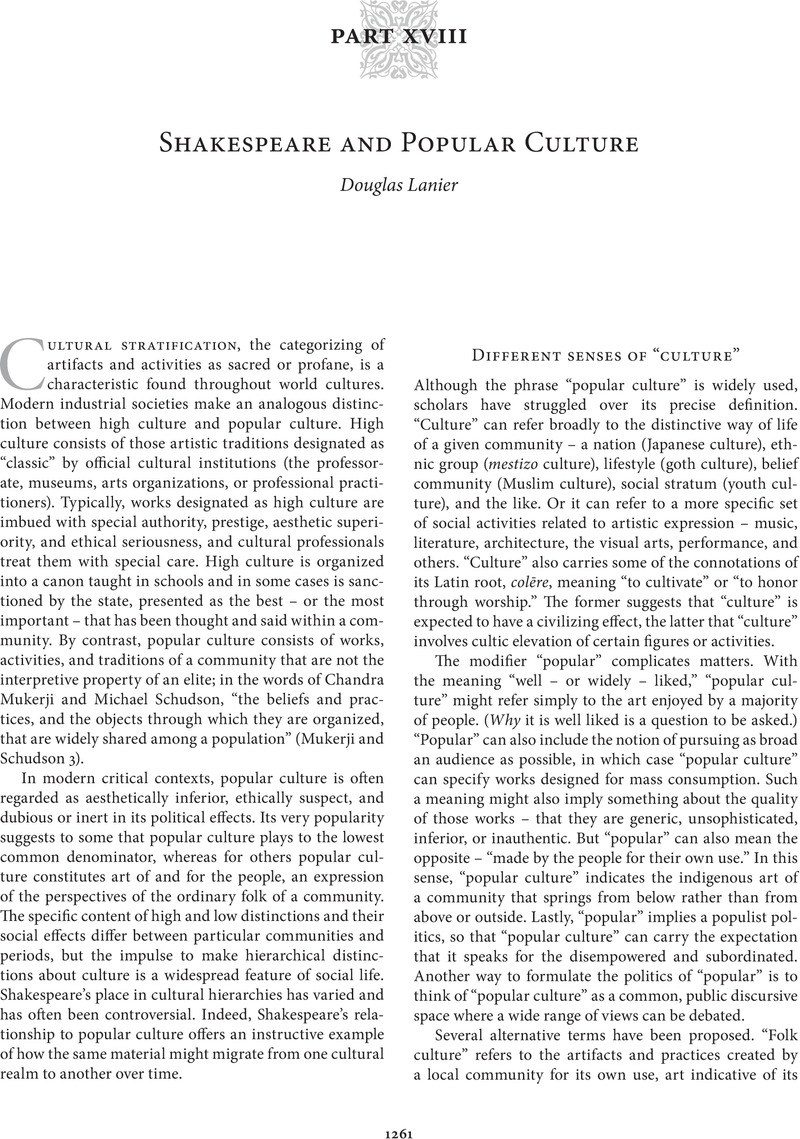Book contents
- The Cambridge Guide to the Worlds of Shakespeare
- Frontispiece
- Frontispiece
- The Cambridge Guide to the Worlds of Shakespeare
- Worlds of Shakespeare
- Copyright page
- Contents
- Illustrations
- Contributors
- Preface
- Acknowledgments
- Abbreviations
- Part I Mapping Shakespeare’s World
- Part II Theater
- Part III Language
- Part IV Science and Technology
- Part V Printing, Publishing, Textuality
- Part VI Visual Arts
- Part VII Popular Culture
- Part VIII High Culture
- Part IX England, 1560–1650
- Part X Religion
- Part XI Medicine
- Part XII The Historical William Shakespeare
- Part XIII Shakespeare’s Fellows
- Part XIV Shakespeare’s Early Reception (to 1660)
- Part XV International Encounters
- Part XVI Making the Scene
- Part XVII Shakespeare as Cultural Icon
- Part XVIII Shakespeare and Popular Culture
- Introduction
- 170 Parody, Burlesque, Satire
- 171 Shakespeare Spin-offs
- 172 Quoting and Misquoting Shakespeare
- 173 Popular Adaptations for Theater
- 174 The Commodified Bard: Shakespeare, Advertising, and Market Culture
- 175 Shakespeare and Popular Music
- 176 Iconic Characters: Overview
- 177 Iconic Characters: Ophelia
- 178 Iconic Characters: Shylock
- 179 Iconic Characters: Romeo and Juliet
- 180 Iconic Characters: Falstaff
- 181 Iconic Characters: Richard III
- 182 Iconic Characters: Othello
- 183 Iconic Characters: Lear
- 184 Iconic Characters: Hamlet as Iconic Image in Russian Culture
- Part XIX Translation
- Part XX Changing Technologies of Stage Performance
- Part XXI Audiences
- Part XXII Production History
- Part XXIII Printing and Reception History
- Part XXIV Shakespeare and the Book
- Part XXV Shakespeare and the Critics
- Part XXVI Shakespeare and the Performing Arts
- Part XXVII Shakespeare and the Visual Arts
- Part XXVIII Shakespeare and Media History
- Index
- References
Introduction
from Part XVIII - Shakespeare and Popular Culture
Published online by Cambridge University Press: 17 August 2019
- The Cambridge Guide to the Worlds of Shakespeare
- Frontispiece
- Frontispiece
- The Cambridge Guide to the Worlds of Shakespeare
- Worlds of Shakespeare
- Copyright page
- Contents
- Illustrations
- Contributors
- Preface
- Acknowledgments
- Abbreviations
- Part I Mapping Shakespeare’s World
- Part II Theater
- Part III Language
- Part IV Science and Technology
- Part V Printing, Publishing, Textuality
- Part VI Visual Arts
- Part VII Popular Culture
- Part VIII High Culture
- Part IX England, 1560–1650
- Part X Religion
- Part XI Medicine
- Part XII The Historical William Shakespeare
- Part XIII Shakespeare’s Fellows
- Part XIV Shakespeare’s Early Reception (to 1660)
- Part XV International Encounters
- Part XVI Making the Scene
- Part XVII Shakespeare as Cultural Icon
- Part XVIII Shakespeare and Popular Culture
- Introduction
- 170 Parody, Burlesque, Satire
- 171 Shakespeare Spin-offs
- 172 Quoting and Misquoting Shakespeare
- 173 Popular Adaptations for Theater
- 174 The Commodified Bard: Shakespeare, Advertising, and Market Culture
- 175 Shakespeare and Popular Music
- 176 Iconic Characters: Overview
- 177 Iconic Characters: Ophelia
- 178 Iconic Characters: Shylock
- 179 Iconic Characters: Romeo and Juliet
- 180 Iconic Characters: Falstaff
- 181 Iconic Characters: Richard III
- 182 Iconic Characters: Othello
- 183 Iconic Characters: Lear
- 184 Iconic Characters: Hamlet as Iconic Image in Russian Culture
- Part XIX Translation
- Part XX Changing Technologies of Stage Performance
- Part XXI Audiences
- Part XXII Production History
- Part XXIII Printing and Reception History
- Part XXIV Shakespeare and the Book
- Part XXV Shakespeare and the Critics
- Part XXVI Shakespeare and the Performing Arts
- Part XXVII Shakespeare and the Visual Arts
- Part XXVIII Shakespeare and Media History
- Index
- References
Summary

- Type
- Chapter
- Information
- The Cambridge Guide to the Worlds of Shakespeare , pp. 1261 - 1273Publisher: Cambridge University PressPrint publication year: 2016

